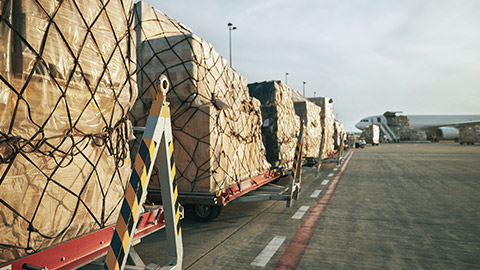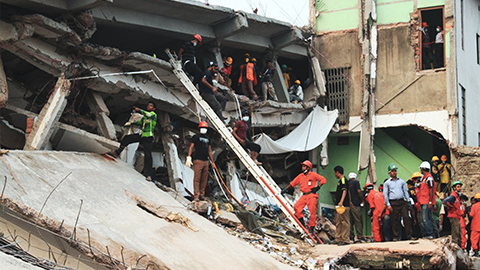Welcome to International Trade. In this topic you will learn about:
- Sources of international law
- Key treaties, conventions and trade agreements
- Governing organisations of international trade
- Australian and other integrated trade regions
- Trans-Pacific Partnership
- Regional International Trade Regimes.
A treaty is an international agreement concluded between States in written form and governed by international law, whether embodied in a single instrument or in two or more related instruments. This is the case of whether the instrument is called a treaty, a convention, or a protocol. There is even a treaty that governs the making of treaties called the Vienna Convention on the Law of Treaties 1969!
You will have the opportunity to explore several treaties that Australia is party to throughout this topic including those that makes global trade possible for Australian businesses. Each country has a process for making, adopting and ratifying treaties.
There are a number of significant international organisations of which Australia is a member. The most well-known international organisation is the United Nations. A number of other international organisations are important for the purposes of international trade including the World Trade Organisation (WTO), the G20, the Organisation for Economic Co-operation and Development (OECD); and regional organisations such as the Asia-Pacific Economic Cooperation (APEC) and the Association of Southeast Asian Nations (ASEAN).
In the topic on international law, you became familiar with the two key sources of international law. These sources also apply to international treaties. Let's recap the key points related to sources of international law.
Formal sources
- Treaties
- International custom
- General principles of law recognised by civilised nations.
Material sources
- Judicial decisions and teachings of jurists.
Hierarchy of sources
The hierarchy of sources refers to the materials and processes that help define the rules and principles used to regulate the international community. According to Article 38 (1) of the Statute of the International Court of Justice (ICJ), the hierarchy of sources are as follows:
- Any treaty provision existing between the parties to the dispute must be applied.
- If there is no treaty, then a rule of international custom must be applied.
- If there is neither a prevailing treaty provision nor a custom, then general principles must be applied.
- In the absence of any of the foregoing, judicial decisions, and writings must be applied.

According to the Vienna Convention on the Law of Treaties, Article 2(1) (1969) a treaty is defined as 'an international agreement concluded between States in a written form and governed by international law, whether embodied in a single instrument or in two or more related instruments and whatever its particular designation'. in simple terms, a treaty is a generic term used to refer to a convention, agreement, protocol, and exchange of notes. Treaties can take a number of forms:
- Multilateral: A multilateral treaty is made between two or more parties and is an equivalent of legislation in municipal law.
- Bilateral: A bilateral treaty is made between two parties.
- Regional: A regional treaty is made between parties in the same region.
Some treaties create law only for those states that are parties to them, some codify pre-existing customary international law with ratification which is, the approval of the treaty by the head of state.
Observing and applying treaties
Every treaty in force is binding upon the parties to it and must be performed by them in good faith.Vienna Convention (1969)
Did you know that the term 'pacta sunt servanda' is Latin for 'agreements must be kept'?
What is the relationship between customary international and treaty law?
When considering the relationship between customary international and treaty law, they have equal authority. If both exist in a disputed issue, treaty law takes precedence; however, a treaty law will not be given precedence over jus cogens (compelling law).
What are peremptory norms?
Peremptory norms (ius cogens or 'compelling law') are fundamental principles of international law from which no derogation (partial suppression of a law) is ever permitted. A treaty provision contrary to jus cogens is deemed as void. Application of erga omnes (Latin for 'towards all or towards everyone'), is accepted and recognised by the international community and may be found either in treaty or custom. Note that the terms jus cogens and ius cogens are used interchangeably and mean the same thing.

Before continuing, watch the following video on the United Nations (UN). The video explains how and why the UN was established and who is a member of the association. Take note of how many member nations comprise the General Assembly, Australian being one member of the UN. Note also that the Millennium Development Goals referred to in the video have been replaced by the Sustainable Development Goals.
To illustrate the legal complexities of international law under which the United Nations must work and operate, read the following case study.
United Nations case study
The following is a summary of a case study with emphasis on the 'Reparations for Injuries Suffered in the Service of the United Nations ICJ Rep. 174'. The Court was asked by the General Assembly to give an advisory opinion on whether the UN, following injury to one of its agents sustained in the performance of his duties, has “…the capacity to bring an international claim against the responsible de jure or de facto government with a view to obtaining the reparation in respect of the damage caused to:
- (a) the United Nations
- (b) the victim or to persons entitled to him?"
The Court was further asked "In the event of an affirmative reply on point (a) how is the action to be reconciled with such rights as may be possessed by the State of which the victim is a national?”
The response to the questions posed to the Court are as follows:
- “Throughout its history, the development of international law...and the progressive increase in the collective activities of States has already given rise to instances of action upon the international plane by certain entities which are not States”
- “In the opinion of the Court the Organisation was intended to exercise and enjoy, and is in fact exercising and enjoying, functions and rights which can only be explained on the basis of possession of a large measure of international personality and the capacity to operate upon an international plane. It is at present the supreme type of international organisation and it could not carry out the intentions of its founders if it was devoid of international personality”
- “The fifty States, representing the vast majority of the members of the international community had the power, in conformity with international law, to bring into being an entity possessing objective international personality and not merely personality recognised by them alone, together with capacity to bring international claims” (ICJ Advisory Opinion).
To conclude, watch the following video ‘What is the United Nations Conference on Trade and Development?’ which explains the purpose of the UN Conference on Trade and Development. This UN affiliate organisation promotes increased trade between nations and aims to break downs barriers to trade and assists Australia and other UN member states.

The law of the sea is made up of rules which regulate relations between states in respect of maritime matters. The 1958 Geneva Conventions on the Law of the Sea is the most important seminal law that governs rules related to maritime issues.
1958 Geneva Conventions on the Law of the Sea
The Conventions and Protocol are the product of the (first) United Nations Conference on the Law of the Sea, held in Geneva from 24 February to 27 April 1958 and include the:
- Convention on the Territorial Sea and Contiguous Zone
- Convention on the High Seas
- Convention on the Continental Shelf
- Convention on Fishing and Conservation of Living Resources of the High Seas.
The conventions apply to a specific area known as the territorial sea. Territorial sea is classified with a 12-nautical mile limit. Coastal states are required to allow innocent passage through territorial sea for specific purposes.
What is a contiguous zone?
The contiguous zone is classified as 24 nautical miles. The coastal state may prevent or punish infringement of its customs, fiscal and immigration laws and so on. The contiguous zone is an exclusive economic zone which extends 200 nautical miles area beyond the territorial sea mentioned earlier. Within this zone, the coastal state has certain rights including:
- sovereign rights of exploration
- exploitation
- conservation and management of natural resources, for example, marine research and the protection of the environment.
What is the continental shelf?
The continental shelf includes submarine areas that extend beyond territorial sea 200 nautical miles and the sovereign rights of exploration and exploitation of natural resources. Within the continental shelf, there is also a deep seabed, which is an area underlying most of the world’s oceans and a common heritage of mankind. Fun fact! The term 'high seas' refers to the freedom of the high seas being open to all states!

Before you continue, spend some time exploring The Organisation for Economic Co-operation and Development (OECD) website. The OECD produces independent analysis and statistics to promote policies to improve economic and social wellbeing across the globe. As an active member since 1971, Australia works with the OECD and member governments to find solutions to common problems through independent analysis and information sharing. Australia maintains a permanent delegation to the OECD, which includes officials from a range of government agencies. This webpage contains an OECD Library that allows you to browse by theme, country or both. Locate publications on the economic outlook of the country you have chosen for your assessments.
The international banking regime (also referred to as the global financial system) is a global framework of institutions and legal agreements that facilitate the flow of financial capital for investment and trade purposes. Select the following headings for more information on the development of international banking standards and guidelines.
Common banking standards and guidelines. The Basel Committee was formed to improve the quality of banking supervision around the world and improve confidence in international banking systems.
In response to the global financial crisis of 2008, Basel III (2012) attempted to improve global banking security and accountability. It introduced a set of reforms to mitigate risk within the international banking sector. For example, requiring banks to maintain certain levels of reserve capital.
What is meant by regional economic integration?
Regional economic integration refers to the 'Common market' which eliminates customs barriers that restrict capital, labour and technology among member states. It is essentially an agreement between countries in a specific geographic region that reduces or removes tariffs and non-tariff barriers that impede the flow of goods and services between the countries. For example, the 'Economic Union' abolishes internal trade barriers to create a single entity and a prime example of this is the European Union.

What is the TPP?
The Trans-Pacific Partnership (TPP) is a trade agreement negotiated since 2010 that exists between 12 countries. The U.S. drives the agenda to suit its most powerful industries and corporations, including pharmaceuticals, media and information technology. The aim is to remove tariffs, which are taxes on imports and exports between the sovereign states along with ‘barriers to trade’ but most of the 29 chapters are not actually about traditional trade issues. From an Australian perspective, the TPP threatens to change Australian laws and policies to suit U.S. corporate interests. The negotiations that take place are kept secret.
Now watch the following video which explains Australia’s Free Trade Agreements and the opportunities these agreements provide Australian businesses.
The video discusses the recently adopted Trans-Pacific Partnership (TPP-11) as well as a bilateral FTA with Peru (PAFTA). FTAs with Japan, Korea and China are also discussed including how these agreements have delivered substantial tariff cuts for many Australian products, supplied across these markets with many tariffs eliminated altogether. Note, how Australian goods and services industries benefit from FTAs through increased growth, higher revenue, job creation and larger profits.
Spend some time exploring the Trade in Services Agreement (TiSA) on the on the Department of Foreign Affairs and Trade website. Read how and when the agreement was made and note the services that are covered by this agreement. Under the ‘Resource’ section of the page read the TiSA FAQs.
Rights of foreign investors to sue over health and environment laws
The right for foreign investors to sue governments over health and environment laws is known as Investor-State Dispute Settlement, or ISDS. A single investor can sue for hundreds of millions of dollars if their investments are ‘harmed’ by a law or policy. The Australian Labor Party (ALP) when in government had a policy against ISDS, and the Howard Coalition did not agree to ISDS in the 2004 US-Australia Free Trade Agreement. However, the current Coalition Government is now prepared to agree to it in the current Trans-Pacific Partnership (TPP).
ISDS and threat to democracy and sovereignty
There are consequences of ISDS such as a perceived threat to Australia's democracy and sovereignty as can be seen in the following short case studies.
The ISDS threatened the democracy and sovereignty of tobacco in Australia. Australia’s tobacco plain packaging law was passed by our parliament. The High Court found that tobacco companies were not entitled to compensation because of the passed law. Philip Morris shifted assets to Hong Kong to use an obscure 1994 investment treaty to sue Australia for hundreds of millions in damages, which consequently, undermines the Commonwealth Parliament and the High Court.
Just the threat of ISDS can have a ‘freezing’ effect on public health or environmental legislation. A U.S. energy company is suing the Canadian provincial government of Quebec for $250 million, because it suspended shale gas mining pending an environmental study. The ISDS could also threaten the regulation of coal seam gas mining in Australia.
Australia has laws for minimum levels of Australian content in film, television and other media to ensure Australian stories are told. The U.S. media companies see these laws as a barrier to trade and want to reduce or abolish them. If these laws were to be reduced or abolished, our ability to preserve and develop our culture in the widespread media, film, and television industries would be threatened.
The TPP, workers’ rights and environmental protection
Competition for investment can lead to a race to the bottom on workers’ rights and the environment unless effective standards are in place. Leaked documents show the TPP contains weak environmental standards which are not enforceable. There is still no agreement for enforceable workers’ rights in contrast to the expansion of corporate rights. The following image conveys the collapse of a Bangladeshi clothing factory in April 2013. The workers were left an unsafe building but were ordered back to work. The building then collapsed, killing 1200 people.

Australian Trade Agreement and democracy concerns
The Australian Trade Agreement can be perceived as a process that lacks democracy. For example, there is no release of text before signing because the Cabinet signs off on text, which then cannot be changed. After the Cabinet signs, the agreement becomes public and is tabled in parliament for 20 sitting days and reviewed by the Joint Standing Committee on Treaties; the text, however, cannot be changed.
It is worth noting that parliament votes only on legislation required for implementation. For example, the ISDS does not require legislation. Other restrictions on future regulations such as food regulations, may not require legislation. This can lock in existing legislation and prevent future reform, for example, intellectual property law. The final ratification takes place after legislation.
The Australian Fair Trade and Investment Network (AFTINET)
The Australian Fair Trade and Investment Network (AFTINET) is a network of 60 unions, community organisations and many individuals campaigning in Australia, for fair trade based on human rights, labour rights and environmental sustainability. The AFTINET also coordinates with similar groups in other TPP countries with regards to fair trade. For further information, you can access the aftinent website here.
Did you know? Trade in services (as opposed to goods) is the focus of the TISA treaty. This is important because Australia’s service sector represents approximately 70 % of Australia’s economic activity.

The European Union (EU) has no customs or tariffs between member nations. The EU negotiates international trade agreements but approval is allowed by individual nations. The EU currently uses competition law that is intended to make sure that there is fair competition between businesses, for example by making rules to control monopolies. The principal institutions of the European Union are outlined as follows:
- European Commission: The European Commission is the exectutive branch of the EU.
- Council of the EU: The Council of the EU is made up of representatives from each member country who meet to discuss, amend, decide on, adopt and coordinate laws, regulations, directives and policies.
- The European Court of Justice: The European Court of Justice is the judician branch of the EU and includes the:
- Court of Justice
- General Court
- European Court of Auditors
- European Central Bank.
The eurozone, also called the euro area is a monetary union for the member states of the EU who have adopted the euro as their currency and legal tender.
Emissions Trading Scheme (ETS)
According to the European Union Commission, an official website of the EU, the aim of the EU emissions trading scheme (or system) is to help members of the EU limit or reduce greenhouse gas emissions. The EU ETS works on the ‘cap and trade’ principles, where a cap is set on the total amount of greenhouse gasses that can be emitted. Over time, it is expected that total emissions will fall. Trading refers to the situation where if a company reduces its emissions, it can keep the spare ‘allowances’ to cover its future needs or sell them to another company.
Challenges that may arise include:
- immigration
- disenfranchisement
- non-uniform areas of law.

The Association of Southeast Asian Nations was created in 1967 . It has 400 million citizens and promotes economic, political and social cooperation. The Association of South-East Asian Nations is made up of the following countries:
- Brunei
- Indonesia
- Malaysia
- the Philippines
- Singapore
- Thailand
- Vietnam.
Asia-Pacific Economic Cooperation (APEC)
APEC was founded in 1989 to promote 'open trade and practical economic cooperation’ and 'a sense of community’ and is comprised of 18 members in the Asia-Pacific region. By 1995 the Gross Domestic Product or the GDP was $13 trillion and it is now responsible for 50 % of total world income and 40 % of global trade.
For more information on APEC explore the Asia-Pacific Economic Cooperation (APEC) website which contains information about Australia’s founding involvement in APEC in 1989. On the top right-hand menu select ‘About APEC’ and explore why APEC was established and what it does. Note, the role this forum plays in reducing the costs for importers and exporters of goods and services.
The North American Free Trade Agreement (NAFTA) is the world’s largest free trade zone between the U.S., Mexico, and Canada. NAFTA works towards the process to remove tariffs also known as duty-free taxes. The goods that are included in these tariffs are categorised into A (for example, automobiles), B (for example, textiles) and C (for example, capital goods such as machinery and tools).
A key NAFTA aim is to eliminate or phase out existing customs duties. In addition, NAFTA prohibits new restrictions on investment and protects intellectual property rights through the following conventions:
- Berne Convention (copyrights)
- Paris Convention for Protection of Industrial Property Rights (patents).
Other NAFTA protections include the environment and labour issues. NAFTA proposed the Free Trade Area of the Americas (FTTA) which was rejected by the United States as was the Trans-Pacific Partnership. This has been followed by a proposal for the Transatlantic Trade and Investment Partnership.
Before we explore the World Trade Organisation (WTO) familiarise yourself with the Trade in Services Agreement (TISA) website which features services as opposed to goods which is the focus of the TISA treaty. Read the information on the webpage regarding how and when the agreement was made and note the services that are covered by this agreement. Under the ‘Resource’ section of the page read the TISA FAQs. Australia’s service sector represents approximately 70 % of Australia’s economic activity and as such is an important consideration in international trade.
The World Trade Organisation (WTO) is the principal multilateral institution regulating international trade and is the successor to the General Agreement on Tariffs and Trade (GATT). The U.S. participates in bilateral and regional trade agreements and WTO, as does Australia. The WTO requires member nations to participate in the following:
- goods and services
- intellectual property rights
- dispute settlement
- trade policy reviews.
Basic principles of the WTO
There are some basic principles the WTO adhere to these include:
- most favored nation treatment
- bound tariffs, which once lowered cannot be raised again
- national treatment, where members may not discriminate against ‘like products’
- gradual freer trade through negotiation
- the Doha Development Round and the Bali Package
- fair competition
- encouragement of development and economic reform.
The WTO aims to address non-tariff barriers and in some cases, tariffs have been replaced as a means of protecting domestics industries threatened by import competition. Environmental and health exceptions have been factored into these barriers in addition to genetically modified organisms (GMOs).
The WTO dispute settlement process
The U.S. is the most active participant in WTO dispute resolution.When a dispute arises a panel is created by the complaining party that issues the reports. Decisions are then made with the enforcement of the WTO. A timetable is also set in place with relation to settling these disputes. For more on the dispute settlement process, watch the following video which describes a case between Japan and Korea.
What is the G20?
The Group of Twenty (G20) is the premier international forum for global economic cooperation. The members of the G20 are: Argentina, Australia, Brazil, Canada, China, France, Germany, India, Indonesia, Italy, Japan, Republic of Korea, Mexico, Russia, Saudi Arabia, South Africa, Turkey, United Kingdom, United States, and the European Union. G20 members account for 86 % of the world economy, 78 % of global trade, and two-thirds of the world's population, including more than half of the world's poor. G20 leaders meet annually at the G20 Summit. Note, the comments in the video voicing criticism of the G20.
End of topic forum
There are forum activities for this topic. For this forum activity you will practice searching the APEC STAR database and complete a case study. Select the ‘Forum’ at the end of your module (which can be found within your navigation menu) and follow the instructions for each question pertaining to Topic 10 within the forum.
The following websites contain additional information about international trade to support your learning.
- UN human rights treaties
- Human Rights Watch
- International Criminal Tribunal former Yugoslavia (ICTY)
- International Court of Justice (ICJ)
- European Convention on Human Rights ECHR
- The American Society of International law. This website is useful for all elements of international law.

